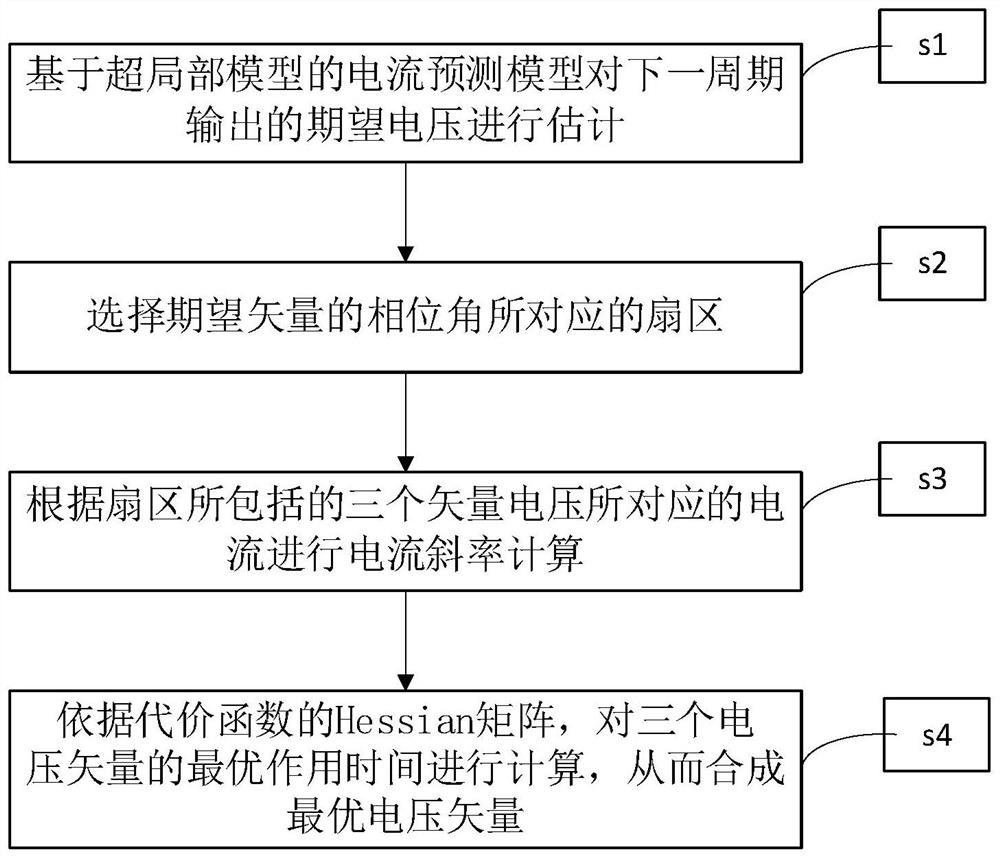Model-free predictive current control method and control system based on three voltage vectors
A technology for predicting current and control methods, applied in vector control systems, control systems, motor generator control, etc. Wave current increases and other problems, to reduce fluctuations and steady-state errors, improve tracking accuracy
- Summary
- Abstract
- Description
- Claims
- Application Information
AI Technical Summary
Problems solved by technology
Method used
Image
Examples
Embodiment 1
[0023] figure 1 A three-voltage vector-based model-free predictive current control method provided in Embodiment 1 of the present invention includes the following steps: establishing a current prediction model based on a super-local model; the method further includes the following steps:
[0024] s1. Estimate the expected voltage output in the next cycle based on the current prediction model of the hyperlocal model;
[0025] s2. Select the sector corresponding to the phase angle of the desired vector;
[0026] s3. Calculate the current slope according to the currents corresponding to the three vector voltages included in the sector;
[0027] s4. Calculate the optimal action time of the three voltage vectors according to the Hessian matrix of the cost function, thereby synthesizing the optimal voltage vector.
[0028] The above scheme is based on the super-local model to avoid the dependence of the system on the motor parameters. At the same time, in order to optimize the pha...
Embodiment 2
[0035] figure 2 A permanent magnet synchronous motor control system based on three-voltage vector model-free predictive current control provided in the second embodiment of the present invention is shown. a speed loop controller for an angle value, a model-free predictive current control module for receiving the reference current output from the speed loop controller, a space vector pulse width modulation module for receiving the optimal action time output by the model-free predictive current control module, receiving The three-phase inverter of the optimal voltage vector output by the space vector pulse width modulation module, the encoder receiving the three-phase AC voltage output by the three-phase inverter, and the position and angle connected to the encoder a detection module; the position and angle detection module forms a closed loop by returning the detected angle to the angle input module;
[0036] A Clark transformation module and a Park transformation module are ...
Embodiment 3
[0041] In the specific implementation, the PMSM model based on the hyperlocal model is established first.
[0042] The expression of the first-order hyperlocal model of a single-input single-output system is as follows:
[0043]
[0044] Among them, Y(t) is the output of the system at time t; U(t) is the input of the system at time t; α is the designable scale factor of the hyperlocal model; F(t) is the parameter set value of the system at time t. Based on the above hyperlocal model, the PMSM model can be expressed as:
[0045]
[0046] Among them, F d is the parameter set value of the d-axis; F q is the parameter set value of the q-axis;
[0047]
[0048] where i d and i q are the current values of the d and q axes, respectively; u d and u q are the input voltage values of the d and q axes, respectively; R s is the resistance of the permanent magnet synchronous motor; L s is the inductance of the permanent magnet synchronous motor; ω r is the electrical...
PUM
 Login to View More
Login to View More Abstract
Description
Claims
Application Information
 Login to View More
Login to View More - R&D
- Intellectual Property
- Life Sciences
- Materials
- Tech Scout
- Unparalleled Data Quality
- Higher Quality Content
- 60% Fewer Hallucinations
Browse by: Latest US Patents, China's latest patents, Technical Efficacy Thesaurus, Application Domain, Technology Topic, Popular Technical Reports.
© 2025 PatSnap. All rights reserved.Legal|Privacy policy|Modern Slavery Act Transparency Statement|Sitemap|About US| Contact US: help@patsnap.com



